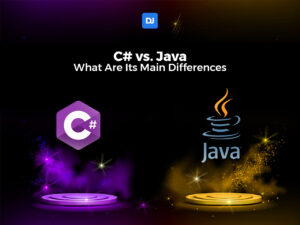Python and Java have over the years solidified as two widely adopted programming languages, often competing for the top three in terms of popularity in many surveys made in the largest programmer communities. Python specifically has seen a boom in usage and popularity in recent years. That fact, however, only fueled the arguments for and against Java vs Python, which still run to this day.
So, which one is better? That depends on a lot of factors. Let’s analyze their differences so you can choose which is better suited for your projects.
Java Programming Language: A Brief Overview
Java is a statically-typed programming language that uses classes as its main form of code organization. Although it supports multiple programming paradigms, it was built first and foremost as an object-oriented language.
Java’s design of being a cross-platform language where you could Write the code Once and Run it Anywhere (WORA) that had access to the Java Virtual Machine (JVM) heavily contributed to its early adoption and popularity.
Java established itself over the years in the software development space, specifically in applications developed for large-scale backends and servers of major companies and, more recently, in Android applications.
Python Programming Language: A Brief Overview
Python is, by contrast, a dynamically-typed, multi-paradigm scripting language. Like Java, Python can be run anywhere so long as there’s access to the Python interpreter. Its simplicity and flexibility are major advantages, allowing the fast development of small or large-scale solutions.
Although Python is older than Java, it didn’t see a massive adoption at first. However, this has changed over the years, and Python is rapidly overtaking Java in terms of general interest and usage.
Java vs Python: An In-depth Comparison
Let’s go over some common operations and test them out to see the difference between Java and Python.
1. Java code VS Python code
Starting out: “Hello world!”
One of the easiest ways to compare two languages is to write out the classical “Hello World!”, where you print the greeting to the screen. Let’s see how you can do that in these two languages.
// Java "Hello World!" Example
public class Main
{
public static void main(String[] args) {
System.out.println("Hello world!");
}
}# Python "Hello World!" Example
print("Hello World!")This is where Python’s scripting background clearly shines in terms of readability and ease of use. In Java, you have to set up the main class and create the main function inside it before even thinking of printing anything. In Python, you can get right down to business.
Starting out: Main function
In a more direct comparison, if you need a main function to pass on arguments to start your application, you can do that in Python too!
// Java Main Example
public class Main
{
public static void main(String[] args) {
if(args.length >= 1) {
System.out.printf("Hello %s!\n", args[0]);
} else {
System.out.printf("Hello random person!\n");
}
}
}# Python Main Example
import sys
def main():
if len(sys.argv) >= 2:
print(f"Hello {sys.argv[1]}!") # sys.argv[0] is always the name of the program (for example 'main.py')
else:
print(f"Hello random person!")
if __name__ == "__main__": # Python sets the special variable '__name__' as '__main__' whenever the module is executed in the top-level code environment. We do this to prevent a module importing this one from triggering main() upon importing it.
main()Unlike Java, however, Python needs a bit more work for the main function to work. Since Java expects it from the get-go, there’s no further need to define it as the point of entry, it automatically assumes it as such and runs it by default. In python, we need to define the main function and then execute it.
Structuring your code: Classes
Both Java and Python support classes, but the way they do so has some key differences.
// Java Class Example
class LibraryPatron {
private int id;
private String name;
private int borrowedBooks;
public LibraryPatron(int id, String name, int borrowedBooks) {
this.id = id;
this.name = name;
this.borrowedBooks = borrowedBooks;
}
public int getId() {
return this.id;
}
public String getName() {
return this.name;
}
public int getBorrowedBooks() {
return this.borrowedBooks;
}
public void display() {
System.out.printf("Patron #%d is %s.\n", this.id, this.name);
}
}
public class Main
{
public static void main(String[] args) {
LibraryPatron libraryPatron0 = new LibraryPatron(0, "Terrence", 5);
libraryPatron0.display();
System.out.printf("They have borrowed %d books.\n", libraryPatron0.getBorrowedBooks());
}
}# Python Class Example
class LibraryPatron:
def __init__(self, id, name, books_borrowed):
self.id = id
self.name = name
self.books_borrowed = books_borrowed
def display(self):
print(f"Patron #{self.id} is {self.name}.")
libraryPatron0 = LibraryPatron(0, "Terrence", 5)
libraryPatron0.display()
print(f"They have borrowed {libraryPatron0.books_borrowed} books.")Immediately of note is the size disparity between the two code snippets.
Java’s code is by far the largest chunk, largely due to the variable declaration and the getters. Variable declaration isn’t needed in Python because object variables are dynamically set on the object.
Also, since Python has no innate concept of private variables (there are ways to obfuscate, but no true way of completely hiding and forbidding the use of a variable), it doesn’t need specific code to access those variables. Just having access to the object itself is enough to get the needed variable value by name.
So while Java is more focused on maintaining the class structure and its inherent member accessibility, Python forgoes those concerns and presents a cleaner, more concise code.
2. Which is faster: Java or Python?
The common conception is that Java is faster than Python, but is that really true? Let’s run some tests to determine if that’s the case.
In order to do so, we’ll take operations that are common between both languages and run it some hundreds of times. Timing these executions will give us a stat to compare both languages in terms of speed.
Test 1: Variable Casting
Casting variables is fairly common. Sometimes you just can’t avoid needing to take a numeric value from an input string, for example. These types of casts are fairly taxing operations. Let’s make a test that helps us time exactly how taxing it is.
// Java Casting Test
public class Main
{
public static void main(String[] args) {
int arrayRange = 1000000;
long startTime = System.currentTimeMillis();
int[] integers = new int[arrayRange];
for (int i = 0; i < arrayRange; ++i) {
integers[i] = i;
}
String[] intStrings = new String[arrayRange];
for (int i = 0; i < arrayRange; ++i) {
intStrings[i] = Integer.toString(integers[i]);
}
int[] stringInts = new int[arrayRange];
for (int i = 0; i < arrayRange; ++i) {
stringInts[i] = Integer.parseInt(intStrings[i]);
}
float[] intFloats = new float[arrayRange];
for (int i = 0; i < arrayRange; ++i) {
intFloats[i] = (float)i;
}
int[] floatInts = new int[arrayRange];
for (int i = 0; i < arrayRange; ++i) {
floatInts[i] = (int)intFloats[i];
}
String[] floatStrings = new String[arrayRange];
for (int i = 0; i < arrayRange; ++i) {
floatStrings[i] = Float.toString(intFloats[i]);
}
float[] stringFloats = new float[arrayRange];
for (int i = 0; i < arrayRange; ++i) {
stringFloats[i] = Float.parseFloat(floatStrings[i]);
}
long executionTime = System.currentTimeMillis() - startTime;
System.out.printf("Execution time: %.3f s", executionTime/1000f);
}
}# Python Casting Test
import time
array_range = 1000000
startTime = time.time()
integers = [i for i in range(array_range)]
int_strings = [str(integers[i]) for i in range(array_range)]
string_ints = [int(int_strings[i]) for i in range(array_range)]
int_floats = [float(integers[i]) for i in range(array_range)]
float_ints = [int(int_floats[i]) for i in range(array_range)]
float_strings = [str(int_floats[i]) for i in range(array_range)]
string_floats = [float(float_strings[i]) for i in range(array_range)]
executionTime = time.time() - startTime
print(f"Execution time: {executionTime:.3f} s")For the sake of fairness, we ran these tests a few times for each and present the results.
Java:
Execution time: 0.170 s
Execution time: 0.175 s
Execution time: 0.174 s
Execution time: 0.174 s
Execution time: 0.177 s
Execution time: 0.173 s
Execution time: 0.175 s
Execution time: 0.180 s
Execution time: 0.176 s
Execution time: 0.174 sAveraging out to 0.175 s.
As for Python:
Execution time: 0.761 s
Execution time: 0.742 s
Execution time: 0.751 s
Execution time: 0.722 s
Execution time: 0.755 s
Execution time: 0.717 s
Execution time: 0.717 s
Execution time: 0.724 s
Execution time: 0.727 s
Execution time: 0.760 sAveraging out to 0.738 s.
This makes Java about 4x faster than Python in these kinds of operations.
Test 2: String Operations
Some of the most time-demanding operations in most languages are string operations. So let’s put both languages to the test in this regard with a simple concatenation test.
// Java String Concatenation Test
public class Main
{
public static void main(String[] args) {
int arrayRange = 1000000;
long startTime = System.currentTimeMillis();
String[] strings1 = new String[arrayRange];
for (int i = 0; i < arrayRange; ++i) {
strings1[i] = "abcdefghij";
}
String[] strings2 = new String[arrayRange];
for (int i = 0; i < arrayRange; ++i) {
strings2[i] = "klmnopqrst";
}
String[] stringsConcat = new String[arrayRange];
for (int i = 0; i < arrayRange; ++i) {
stringsConcat[i] = "";
}
for (int i = 0; i < arrayRange; ++i) {
stringsConcat[i] = strings1[i] + strings2[i];
}
long executionTime = System.currentTimeMillis() - startTime;
System.out.printf("Execution time: %.3f s", executionTime/1000f);
}
}# Python String Concatenation Test
import time
array_range = 1000000
startTime = time.time()
strings_1 = ["abcdefghij" for i in range(array_range)]
strings_2 = ["klmnopqrst" for i in range(array_range)]
strings_concat = ["" for i in range(array_range)]
for i in range(array_range):
strings_concat[i] = strings_1[i] + strings_2[i]
executionTime = time.time() - startTime
print(f"Execution time: {executionTime:.3f} s")Again, for the sake of fairness, we ran these tests a few times for each and present the results.
Java:
Execution time: 0.102 s
Execution time: 0.115 s
Execution time: 0.104 s
Execution time: 0.101 s
Execution time: 0.107 s
Execution time: 0.102 s
Execution time: 0.109 s
Execution time: 0.106 s
Execution time: 0.102 s
Execution time: 0.105 sAveraging out to 0.105 s.
As for Python:
Execution time: 0.158 s
Execution time: 0.165 s
Execution time: 0.158 s
Execution time: 0.164 s
Execution time: 0.161 s
Execution time: 0.167 s
Execution time: 0.175 s
Execution time: 0.160 s
Execution time: 0.160 s
Execution time: 0.166 sAveraging out to 0.163 s.
The difference isn’t so pronounced in this case, but Java still edges out being 1.5x faster than Python for these sorts of operations.
Conclusion: Java is generally Faster
If you are working on a project where execution time is important, Java is clearly the safer option.
However, remember that at the end of the day these are still very small time differences in practical terms and will probably be unnoticeable to most users.
When to use Java or Python?
While both languages are very similar in terms of functionality, both Java and Python have settled themselves into branches of the industry for certain types of projects due to their unique characteristics.
Java has established itself as a language extensively used in Enterprise solutions and Android App development. Also, it has seen use in academic research for both Artificial Intelligence and Natural Language Processing.
Python, on the other hand, is seeing increased use in scripting components for many software solutions and other fields in need of a dynamic, easy-to-use language, such as Machine Learning and Scientific computing. Tensorflow, Google’s open-source library for machine learning and artificial intelligence, is written in Python.
Let’s look at some other specific cases.
Java or Python for: Learning How to Code?
When starting out, developing in a language that is easy to write and understand makes the learning process easier. Python wins in this regard, which is why it has seen such an increase in popularity and adoption in the last few years.
As can be seen by our examples, outside of each languages’ quirks, most basic concepts you learn are transferrable between them. Learning Python or Java will certainly prepare you to change over to the other if you so wish or require.
Java or Python for: Game Development?
Java and Python also have maintained a sizeable community of game developers over the years, but neither have been able to overthrow the well-established C++ and, more recently, the fast blooming C#.
Python, however, has seen more use in game development, but on the scripting side.
Most games nowadays require a powerful scripting language to help in their framework development, and Python can be used effectively for that purpose. Games such as EVE Online and Mount&Blade, for example, use Python as a scripting language to power some of their systems.
Other popular game development tools, such as Blender3D, also use Python as its scripting language to create plugins and automate work.
Java or Python for: Web Development?
If there’s one field where Java and Python are used extensively, it’s web development. They are usually used in backend frameworks, and there are several libraries that leverage the power of both languages for this purpose.
Python is used as the backbone for many web apps backend libraries, such as Django and Flask. Django is included in popular tech stacks used in web app development and is used by several big companies including YouTube, Spotify, Instagram, Pinterest, NASA, Mozilla, National Geographic, Atlassian, and Udemy.
Java has Spring as one of its most popular backend frameworks, powering backends for large companies such as Netflix and Target.
Conclusion
In the end, the choice between Java and Python will be decided by the needs of the team or person using it.
Both languages are powerful in their own right and can serve the needs of any project. Java gains the upper hand in terms of performance, but Python has several other advantages. It’s gaining traction in a lot of fields as both a dynamic language and as a scripting tool due to its flexibility, readability, and ease of use.
If you’re starting out or looking for a new language to add to your programming repertoire, you can’t go wrong with Python.
But don’t dismiss Java out of hand! It’s an old and established technology that is still in use by many companies. If you want to be a versatile developer, you should keep it in mind.
Whether you’re looking for experienced Java developers, Python developers, or even Django developers for your project or company, DistantJob can help you find the perfect fit.





